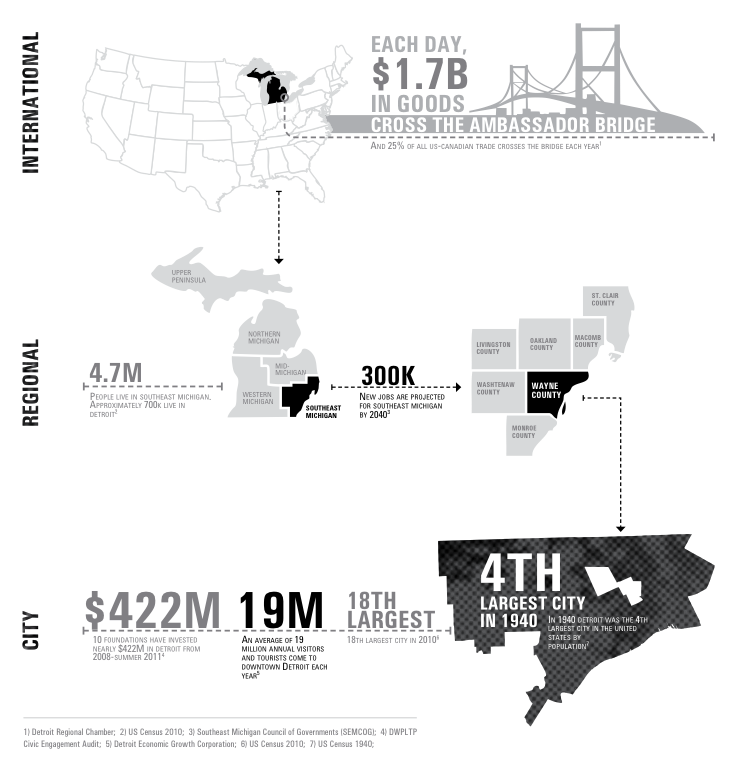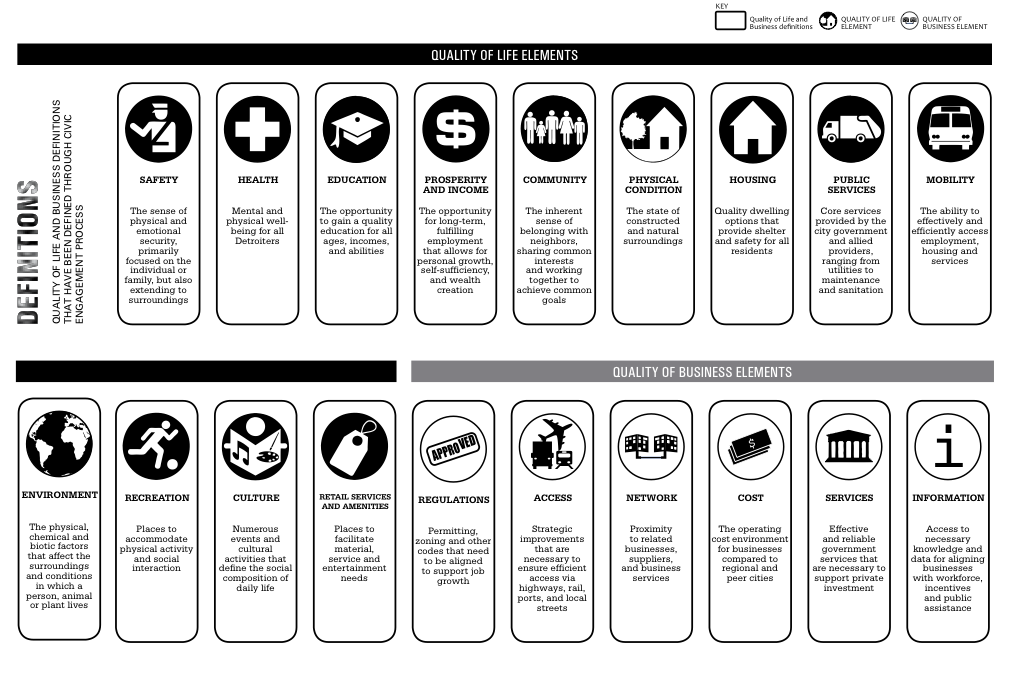DETROIT WORKS PROJECT
This document, the Detroit Strategic Framework, articulates a shared vision for Detroit’s future, and recommends specific actions for reaching that future. The vision resulted from a 24-month-long public process that drew upon interactions among Detroit residents and civic leaders from both the nonprofit and for-profit sectors, who together formed a broad-based group of community experts. From the results of this citywide public engagement effort, in turn, a team of technical experts crafted and refined the vision, rendered specific strategies for reaching it, shared their work publicly at key points, and shaped it in response to changing information and community feedback throughout the process.
The work of the Detroit Strategic Framework was guided by a talented Steering Committee of individuals from within Detroit, whose knowledge of civic engagement, nonprofit community work, key areas such as land use and economic development, and the city itself were of deep value. Building a blueprint for a city as complex and rich in promise and challenges as Detroit required the integration of local expertise with leading thinkers and practitioners from around the globe. A list of the Planning and Civic Engagement Teams, along with the committees that guided the work and the Process Leaders who helped create the vision, is provided in the acknowledgements appendix of this document.
A FRAMEWORK THAT BUILDS ON ASSETS. Detroit is no stranger to plans and proposed solutions to its need for urban revitalization. Twice in the past 15 years, Detroit has prepared a full citywide plan for its future: The 1998 Community Reinvestment Strategy Plan (which was never formally adopted), and the state- mandated Master Plan of Policies governing land use, created in 2004 and adopted by the City Council in 2009. The Detroit Strategic Framework marks the first time in decades that Detroit has considered its future not only from a standpoint of land use or economic growth, but in the context of city systems, neighborhood vision, the critical question of vacant land and buildings, and the need for greater civic capacity to address the systemic change necessary for Detroit’s success. This plan is also the first to accept and address Detroit’s future as a city that will not regain its peak population of nearly 2 million people.
Every city has its challenges and Detroit most certainly has urgent and long-standing ones. But not every city has the assets of Detroit. As Michigan’s largest urban center, Detroit is home to the largest concentration of workers, health, education, cultural, and entertainment institutions; the busiest international border crossing in North America for international trade; host to 50 million annual tourists and visitors; a city of beautiful historic neighborhoods and commercial areas, including 245 sites or districts on the National Register of Historic Places and 8 National Historic Landmarks; and the second largest theater district in the country, second only to New York City. These assets make up the city’s physical and economic capital.
Detroit’s assets also include the resiliency, creativity, and ingenuity of its people and organizations—the city’s human and social capital. Detroit’s impressive talent base includes
- business leaders who forever changed the culture of industrial production and music;
- pioneers in new forms of transportation, infrastructure, and community food production;
- civic leaders who have organized and empowered community residents to exercise their voices and actively participate in the fate of their futures; and
- faith leaders who have held up Detroit communities by tending to their spiritual and human needs.
…
Things We Must Do
Quality of Life/Quality of Business Imperatives
The Detroit community and planning experts worked together to identify the important core values, project goals, quality-of-life, and quality-of-business elements that have driven the recommendations in this Framework. Early engagement efforts revealed that issues of access to jobs, safety, education, human health, and neighborhood appearance were universally critical to address. These sentiments were uniformly raised regardless of neighborhood population, ethnicity, income, or geography. Residents and businesses alike wanted an improved city and a better quality of life and business environment.
Through these public conversations, the Long-Term Planning initiative focused its work on defining what an improved quality of life and business would require, and created a set of “mandates” that must be established if Detroit is to achieve visible and sustainable change. These 12 Imperatives are drawn from the quality-of-life and quality-of-business elements identified in the collaborative dialogue between technical and community experts.
Looking carefully at the data revealed by the policy audits described earlier, it became clear that “if we did nothing”, the quality of life and businesses in Detroit would continue to decline. The scope of the planning effort focused on priorities for change as defined by the 12 imperatives.
Read full report (PDF) here: Detroit Future City
About The Detroit Works Project
detroitworksproject.com
“The Detroit Works Project was introduced in 2010 as a process to create a shared, achievable vision for Detroit’s future to improve the quality of life and business in Detroit. It began with a series of meetings to engage residents in the process. Initially we heard from nearly 10,000 of you who told us for Detroit to work, action is needed today while we continue to plan for tomorrow.”
Tags: Detroit, Energy, future city, planning, strategic framework plan








 RSS Feed
RSS Feed